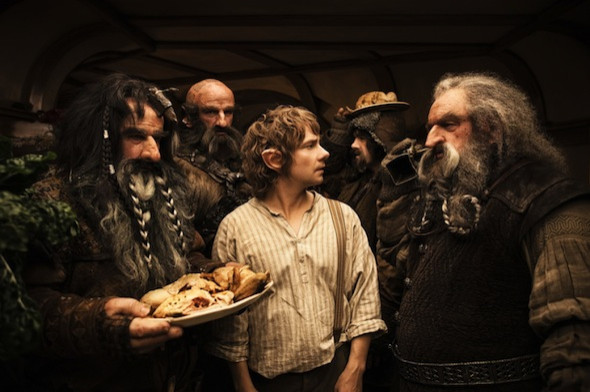‘The Hobbit: An Unexpected Journey’ Review: Tolkien's World, Up Close

With "Lord of the Rings," Peter Jackson altered the landscape of cinema. "The Hobbit: An Unexpected Journey" serves to remind audiences that he is still a cinematic visionary. Still, while “The Hobbit” is at times a wondrous meditation on friendship and mysticism, Jackson’s self-indulgence does not always serve the movie well.
The film is a prequel to the "Lord of the Rings" trilogy and a celebration of the enchanting world J.R.R. Tolkien created 75 years ago. Released in 1937, "The Hobbit" is what first introduced readers to the mythology of Middle-earth. The beloved adventure tale has sold 100 million copies and has been translated into 50 languages. It has inspired plays, cartoons, a radio series, comics, and games. Peter Jackson's adaptation marks the first time the novel has been adapted for the screen.
Set 60 years prior to the "Rings" trilogy, "The Hobbit" follows the story of Bilbo Baggins. Bilbo, who lives a tranquil life of relative isolation, is commissioned by the Wizard Gandalf (Ian McKellen) to help reclaim the lost Dwarf Kingdom of Erebor. In order to do so, he must defeat the evil dragon Smaug. Bilbo is persuaded to do so after 13 dwarves, led by the Dwarf king Thorin (Richard Armitage), cram into his modest house and plead for his help. From there, the group embarks on a treacherous journey paved with mysterious creatures and obstacles.
With no shortage of light-hearted moments and comical farce, the tone of "The Hobbit" is far more buoyant than that of its predecessors.
One of the film’s major strengths is how it conveys the camaraderie between the dwarves, which factors heavily into Tolkien's novel. They clash and tease one another but ultimately work as a united family eager to protect their own. Each Dwarf is also physically unique, a testament to Peter Swore King's masterful hair and makeup work and the "dwarf boot camp" that the actors attended prior to filming, which allowed them to develop matchless interpretations of their characters.
Freeman, known for his role as the lovesick Tim on the original, UK version of "The Office" is perfectly cast as the reluctant hero. Armitage, known primarily for his work on BBC period dramas like "North and South" and "Robin Hood," brings a considerable amount of depth to the role of the headstrong but sympathetic Thorin. The presence of McKellen, who no doubt owns the role, provides a welcome link to the "Rings" series.
The same may be said for the brief appearances of Frodo (Elijah Wood), Elf Lord Elrond (Hugo Weaving), Queen Galadriel (Cate Blanchett) and Saruman (Christopher Lee). Furthermore, one of the film's best scenes includes Bilbo's run-in with Gollum ("Rings" standout Andy Serkis), who challenges him to a game of riddles in exchange for directions.
There's no disputing that "The Hobbit" has much to live up to. The "Rings" films (which was released from 2001-2003) earned glowing reviews, a die-hard fan base, and a whopping $3 billion globally. The final installment in the trilogy,"The Return of the King," earned 11 Oscars, including Best Picture. Several critics have noted that “The Hobbit” does not reach the heights of grandeur that "Rings" did nearly a decade ago. It's true that "Rings" fans will likely find fault with "The Hobbit's" childlike tone, but while comparisons between the two trilogies are inevitable, "The Hobbit" should be viewed as a distinct work: "Rings" has a far more intricate plot than Bilbo's tale, which Tolkien initially wrote as a bedtime story for his children. "The Hobbit" reads more like a convivial parable than a literary epic--which likely proved challenging for Jackson and the film's additional screenwriters Fran Walsh, Philippa Boynes, and Guillermo Del Toro (who penned the earliest versions of the script).
"The Hobbit" is the first film to utilize a High Frame Rate technology, which plays images at a rate of 48-frames-per-second rather than the traditional 24-frames-per-second. Yet Jackson's decision to pioneer a new form of filmmaking has had mixed reactions. Indeed, it does take some getting used to. Many will find that it takes about 10-15 minutes to adjust to the film's speedy frame rate or find it altogether straining. Still, the bulk of the scenes are served well by the innovative format. This is particularly true of the countless establishing shots and aerial views. However, the HFR technology does not work in a few fast-paced action sequences, which come off as campy and low-budget.
Equally disappointing are a few poorly blocked scenes that would have worked better in an early 1900's silent film, including a battle scene involving the Great Goblin (Barry Humphries). At times, the film is comparable -- not in a good way -- to the "Clash of the Titans" films--With far too many capture and rescue sequences that are silly and devoid of inspiration.
At a runtime of nearly three hours, “The Hobbit” could have been whittled down considerably. There is an overabundance of exposition shots that revel in the tale's atmosphere and delay the progression of the plot. Though fans of the book may relish Jackson's decision to savor each and every minor detail of the story, casual filmgoers will find it tedious. And it’s not over yet: Jackson is tasked with stretching a 297-page book into three films, "The Hobbit: The Desolation of Smaug" and "The Hobbit: There and Back Again" and are set to debut in 2013 and 2014 respectively.
Despite the film's flaws, "The Hobbit" is a whimsical journey that reminds us of the joyful escapism a cinematic adventure can provide.
© Copyright IBTimes 2024. All rights reserved.





















